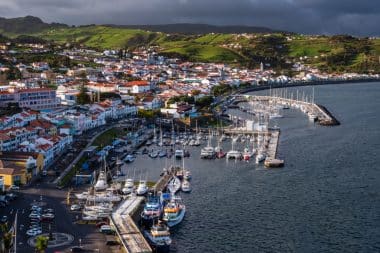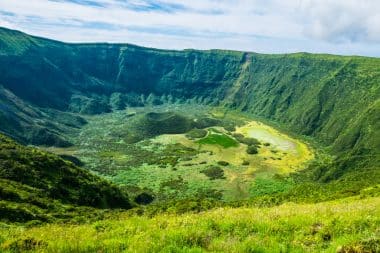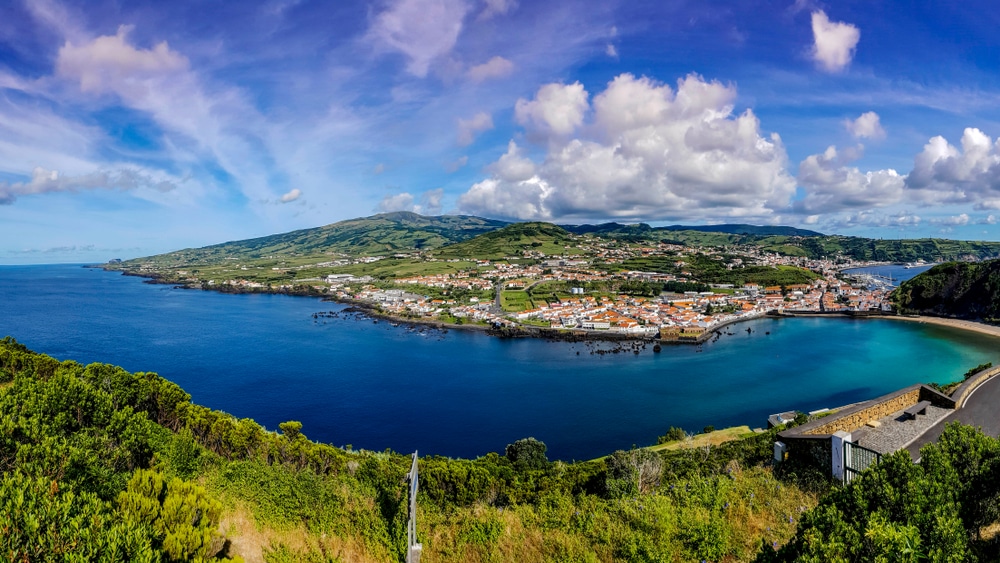The Portuguese archipelago of the Azores is considered particularly attractive. Among the most picturesque islands is the fifth largest island, Faial, also known as Ilha Azul (Blue Island). The island got its affectionate nickname because of the blue blossoms of the hydrangea hedges that characterize the island. From the sophisticated island capital to the beautiful beaches and the volcanic landscapes, the Portuguese island paradise has a lot to offer.
Horta – the island’s capital with international flair

Faial played a very special role among the Azores islands and this is also reflected in the development of the fashionable island capital Horta. Discovered by Henry the Navigator, the island of Faial was settled in the first half of the 15th century. The city of Horta was shaped by the large landowners who settled here and ensured a townscape befitting their status. This is evidenced, among other things, by the Igreja Matriz Sao Salvador in the center of the city, which catches the eye with its monumental baroque façade. From the In the 19th century, the influence of the American whalers was added and at the beginning of the In the 20th century, the relay station for submarine cables was built in Horta, which was an important communication hub between Europe and America. All this provided the international flair of the city, which still fascinates visitors today.
Today, Horta is the epitome of a picturesque coastal town with its mansions, churches and a charming waterfront. Especially the old town area with its magnificent buildings inspires and surprises at the same time. Beautifully landscaped gardens and parks invite you to linger, the marina provides maritime flair and the colourful displays of the town’s small shops invite you to go shopping, as does the city’s large market hall. Beautiful little cafés and restaurants entice you with specialties of the island cuisine, but also with international specialties.
Faial’s fascinating volcanic landscape
With its bizarre volcanic landscapes, Faisal is particularly worth seeing. Characterized by the volcanic crater Caldeira do Cobeco Gordo, which is located in the center of the island, the island has many special features. The volcanic crater impresses with a diameter of two kilometers. At the western tip of the island there is a particularly bizarre landscape, because a new mountain was built here from 1957 to 1958. This natural wonder dates back to the eruption of a volcano lying under the sea. The visitor centre located here vividly presents the eruption and the emergence of the new landscape.
Caldeira do Faial – the wilderness surrounded by civilization
Nature lovers should not miss the Caldeira do Faial. Here at the crater, which is up to 400 meters deep, there is vegetation untouched by humans. It is particularly attractive to walk around the crater. A corresponding hiking trail leads along the crater rim, so that the circumnavigation takes about 2.5 hours. From the crater, however, you can also enjoy a magnificent view and the Azores island seems to be at the feet of hikers. In good weather, the view extends to the neighboring islands of Pico and Sao Jorge and even to Graciosa.
Tips for carefree beach fun
The beautiful Azores island offers beautiful beaches that invite you to relax. One of the highlights is the Praia do Porto Pim beach, which is located at the foot of Monte de Guia and not far from the city of Horta. Where once the whalers moored their boats, beachgoers can now enjoy carefree bathing pleasures on the bright fine sandy beach.
North of Horta, on the other hand, the Praia do Almoxarife beckons. The dark sandy beach is a good 4 km from the ferry port and looks wildly romantic. The beach of volcanic origin is a great place to enjoy the sun, but the current can be treacherous, so families usually prefer Praia do Porto Pim.
A fantastic natural swimming pool can be found in the former Varadouro spa. Here in the southwest of the island, bathing becomes a nature experience, because the natural lava pools are particularly pleasant and located in a particularly picturesque environment.
Watching whales in their natural environment

One of the impressive possibilities offered by a holiday in Faial is whale watching. All year round, different species of whales and dolphins can be observed around the island paradise. In the period from February to June, nature lovers can also observe the giants of the seas in the form of humpback whales and blue whales and listen to their distinctive songs. The impressive animals weigh up to 200 tons and impress with a length of up to 33 meters. In addition to boat tours for whale and dolphin watching, the whaling museum with its impressive exhibits and the whale watching posts on land are also recommended.


